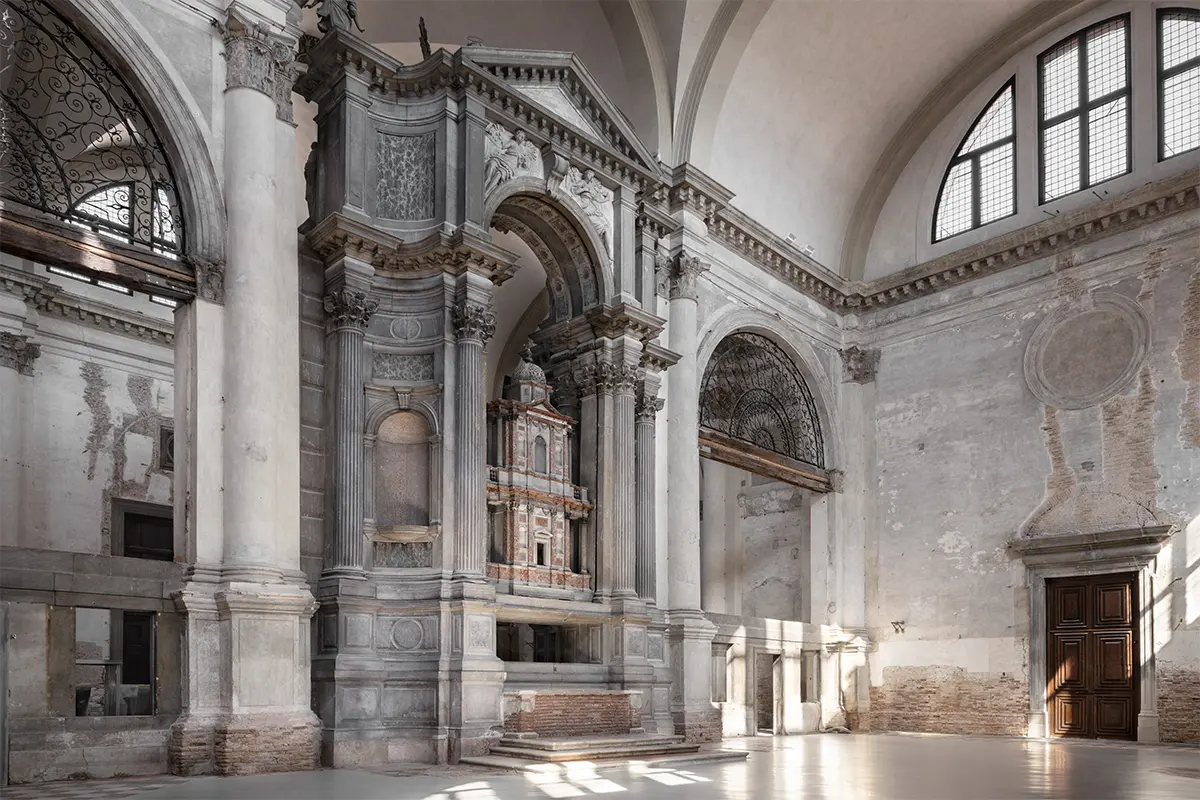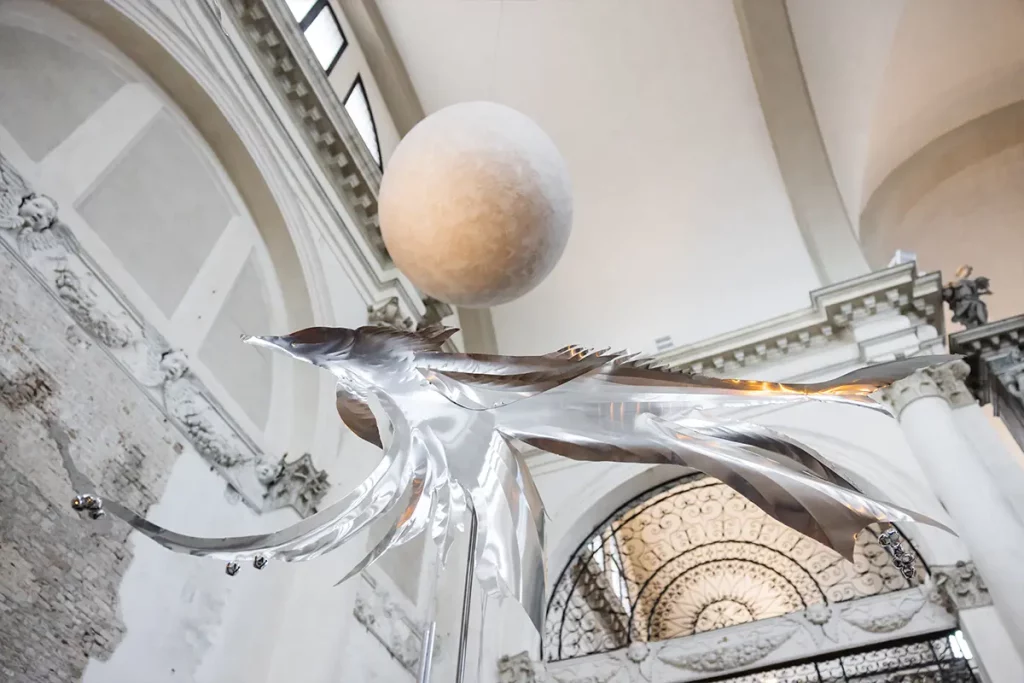Ocean Space 2023 program unfolded: a platform for inter-trans-cross-disciplinaries discourse. Simone Fattal and Petrit Halilaj & Álvaro Urbano use art to question and protest
Ocean Space: San Lorenzo church renovated by TBA21-Academy
A stereotypical view sees cultural institutions as somewhat old, distant from the practicality of everyday life. Some try to challenge this idea. They do so in different ways: from papers, to academia, to a variety of initiatives. Searching for a different way of experiencing culture in Venice, the place to look is San Lorenzo. Just a few minutes’ walk from Santa Maria Formosa, inside the former church, recently renovated by TBA21-Academy, the visitor will find the very-much-alive universe of Ocean Space.
In their own words: «Ocean Space is a planetary center for exhibitions, research and public programs catalyzing critical ocean literacy, collaborative research, and environmental advocacy through the arts». The description is fitting. With its atmosphere of constant turmoil, Ocean Space seems to remind of the XX century cultural vanguards – made contemporary.
Thus Waves Come in pairs: The Current III
The exhibition Thus Waves Come in Pairs starts the 2023 program, the beating heart around which all other activities evolve – central to the conversation. It features American-Lebanese, Paris-based artist Simone Fattal and Berlin-based artist duo Petrit Halilaj & Álvaro Urbano. The new installation by Halilaj & Urbano is co-commissioned by TBA21–Academy and Audemars Piguet Contemporary.
The exhibition is named after a line from the poem Sea and Fog by Lebanese-American poet, essayist, and visual artist Etel Adnan; curated by Barbara Casavecchia as the third cycle of The Current (2021-2023). This year’s exhibition closes the cycle. The full journey is illustrated in the book «Thus Waves Come in Pairs. Thinking with the Mediterraneans» published by Stenberg Press.
The Current: the new format
«The first two cycles, starting in 2015,» explains Markus Reymann, director of TBA21-Academy, «were a different format: we invited guest curators to lead three years cycles» that started a moment of togetherness, in which curators extended the invite to five experts from different disciplines to spend two weeks at a time on a boat and reflect on the question «What is the ocean?».
The Current was originally thought as a «platform for inter-trans-cross-disciplinaries discourse». In 2019, after opening Ocean Space in Venice, they decided to abandon the ship and focus on space. The aim of the new format is «creating a network of people from all across the shores of the Mediterranean». From there, the whole project evolved: «the wave continued working like it does». Giving birth to a distributed and decentralized approach.
The Mediterraneans: as a plural
As curator Barbara Casavecchia explains, the whole concept is «articulated around the body of water we call the Mediterraneans». There is a reason behind the linguistic choice: «we decided to pluralize the term Mediterraneans in order to question the dangers of the single stories, too many Eurocentric perspectives and colonial ways to create knowledge».
After freeing the concept from the dangers and imposition of the single narrative, it becomes possible to build new ones: «we tried to find stories and understandings emerging from positions situated along all the shores and try and learn from them», Casavecchia recounts, «especially from those who inhabit the rapidly expanding condition of aridity».
Ocean Space: rethinking from the crisis
Aridity is a key concept, «an expanding condition we are all coming to terms with». It must be questioned. The Mediterraneans are immersed in a crisis that moves twenty percent faster than any other region on the planet: «we need to learn from those who are at the forefront of these changes that we are all part of».
Languages and answers might not always be obvious. Far from obvious is the fact that, when you visit Ocean Space, surrounded by the lagoon of Venice, you are in fact in an arid environment: «there is an abundance of water» Casavecchia explains, «but a scarcity of Sweetwater». Realities must be questioned even – or especially – when they seem obvious.
Queering, asking, questioning: Ocean Space 2023 open program
Sometimes the best answer is not looking for answers at all. No easy way out – or, as the famous Donna Haraay quote goes, «staying with the trouble». Sadly, in the context of the climate and social crisis of our time, the practice of questioning rather than looking for answers is not often considered an option. It is at Ocean Space. «A lot of people are obsessed with a silver bullet solution» noticess Reymann.
This is not what art is supposed to do: «these are not solutions, these are openings of questions, experiences to be shared that open up curiosities that then are being unfolded and acted upon» through the vast participated open program Ocean Space offers that will run until the closing of the season on the fifth of November 2023.
Fighting one battle, fighting them all – everything is interconnected
Once you choose to stay with the trouble and ask questions, connections, weavings, inter-weavings start to emerge. In its first years of life, TBA21-Academy was focusing mainly on the ocean and its relations to climatic evolution. Step by step, question after question, it became clear that fighting the battle that came with the investigation of climate change meant so much more.
«We cannot say ocean without climate, we cannot say climate without social justice, we cannot say social justice without environmental justice, and so on». Justice is a comprehensive concept that cannot and should not be fragmented. At that point, the ocean itself unfolded, transformed: « it became a metaphor and a tool to challenge our land-based logic and land-based binaries and really start thinking with change, with fluidity».
Petrit Halilaj & Álvaro Urbano: the west wing
The notions of queering, questioning and plurality of meaning is central in the works exhibited this year as well. This is the case for Lunar Ensamble for Uprising Seas by Petrit Halilaj & Álvaro Urbano, as Audemars Piguet curator and co-commissioner of the work Audrey Teichmann explains. It is about «a song that a grandmother used to sing to a grandchild and that became the song of a family», and so much more.
The installation «is an open stage to host imagination, a rehearsal for the future». The west wing is filled with metallic creatures, sculptures, and beings. At dusk, at the touch of a sapient hand, they become alive, transforming into instruments.
Arts comes alive: the performance
At varying durations and intervals during the season, twenty performers, together with the artists, embarked on a dance that almost looked – and felt – tribal, ritual. It all happened under a moon/egg-shaped sculpture, hanging from the ceiling: an influence, symbol related to birth and beginnings in so many cultures.
The performance, in Casavecchia’s words, «is also a parade, maybe a protest against human inability to listen to the language of the other – maybe a Raindance to call for water. A way of queering the notion of a stable and fixed natural identity and hence the possibility to imagine alternative futures, queer futures and encounter spices that bring their intelligence to our understanding of reality».
It has something more: the breathtaking strength that only irrationally relatable art, moments, or experiences have. Unspeakable and instinctive feeling of belonging to and understanding something that is, at the same time, entirely else and never fully knowable. Looking at the performance means agreeing to become like children for some time again: almost frighteningly open to the world.
Simone Fattal: the east wing
Simone Fattal’s installation in the east wing of Ocean Space, is titled after a verse from the poem L’homme et la mer by Charles Baudelaire, Sempre il mare, uomo libero, amerai! (Free man, you’ll love the ocean endlessly!). In his verses, the poet describes the waves of the sea as a mirror for the soul. In Fattal’s sculptures on show at Ocean Space, as she explains, the sea is represented by glasses placed on the floor.
In French, la mer (the sea) is a feminine, an entity that, in the poem, has a generative and nourishing force. Two sculptures occupy the altar’s niches: a little boy, interrogating the public about the future; and a tondo recalling the ancient temple of Apollo at Delphi, with the famous inscription γνῶθι σεαυτόν (gnōthi seautón, know thyself) – «I thought we need that again» comments the artist.
The piece also puts the nature of the building, a church, in relation with a temple of old times. The mirror was made in Venice: «I wanted to connect Venice with my work». Fattal’s work, she explained, is about « bringing civilizations together, and regions together». After all, «the Mediterranean is half Arabic and half European, and these two regions never ceased to communicate, commerce, speak together».
Ghaylán and Máyya: rivals, lovers
Another sculpture by Fattal shows two monumental figures, separated and joined by a Golden Sea in glass tiles: Máyya and Ghaylán. They are celebrated in classic Arab poetry, as well as in folktales and legends spread throughout the Islamic world.
In the Persian Gulf, their story is that of two owners of a flotilla of vessels engaged in the pearl trade. Máyya has faster ships, which make her excel. One day, observing the wings of a dragonfly resting on his shoulder, Ghaylán realizes how to harness the wind. He thus invents sails and outran his beloved’s boats. Once again, they seem to be asking the viewer a question: will humans be able to continue to find solutions by learning from nature?
Simone Fattal
Visual artist born in Damascus, Syria, and raised in Lebanon. She left Lebanon in 1980 and settled in California, where she founded the Post-Apollo Press, a publishing house dedicated to innovative and experimental literary work.
Petrit Halilaj (b. 1986, Kostërrc-Skenderaj, Kosovo) and Álvaro Urbano (b. 1983, Madrid, Spain)
Visual artists based in Berlin. Halilaj’s practice emerges from his personal experiences, reflecting on individual and collective memories, freedoms, and cultural identities and Urbano’s work invites dialogue between different living entities to establish newly conceived environments.




















